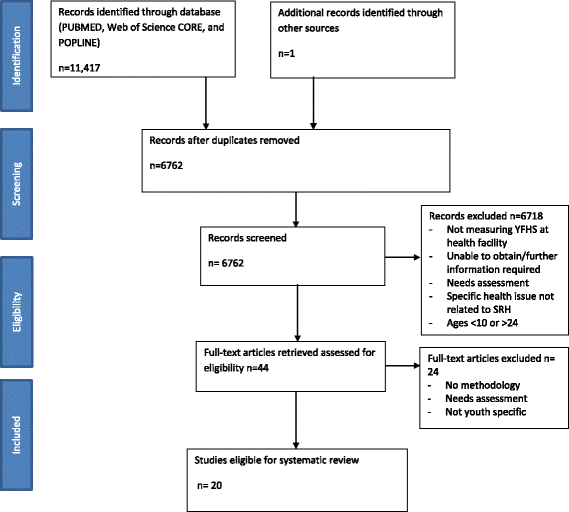Assessing youth-friendly sexual and reproductive health services: a systematic review
- PMID: 29587727
- PMCID: PMC5870922
- DOI: 10.1186/s12913-018-2982-4
Assessing youth-friendly sexual and reproductive health services: a systematic review
Abstract
Background: Over the last quarter century, there has been an emergence of evidence-based research directed toward the development, implementation, and assessment of youth-friendly health services (YFHS) to improve the delivery of sexual and reproductive health services for young people. Despite these research efforts, evidence supporting the effectiveness of YFHS is limited, which may be attributed to a lack of consensus on how to define and measure youth-friendliness to track progress and evaluate outcomes. The purpose of this systematic review is to assess how youth-friendly sexual and reproductive health services are measured worldwide.
Methods: We conducted a systematic review of studies measuring youth-friendly sexual and reproductive health services at health facilities published between January 2000 and June 2015 using PubMed, Web of Science, and POPLINE databases. Additional studies were identified by reviewing references of selected articles. Studies were screened to identify measurements and indicators that have been used to measure YFHS.
Results: Our review identified 20 studies from an initial search of more than 11,000 records, including six from high-income countries and 14 from low-and middle-income countries. The review identified 115 indicators used for measuring youth-friendly sexual and reproductive health services. Our review found a lack of consistency in the tools and indicators used to measure YFHS. The three most frequently assessed domains were accessibility, staff characteristics and competency, and confidentiality and privacy. The majority of the indicators were not specific to young people's needs and often reflected basic standards of care.
Conclusions: This review shows the need for standardization and prioritization of indicators for the evaluation of YFHS. The results can be used to identify a core set of indicators that can be incorporated into a framework for assessing youth-friendly sexual and reproductive health services. There is a need to further distinguish between those variables that may have greatest impact on the use of services by young people, such as respect and privacy, those that impact the quality of services offered, and those that have limited relevance. Conducting more rigorous studies using a refined set of indicators is critical to measure and compare the impact and effectiveness of YFHS efforts.
Keywords: Adolescent; Global; Indicators; Measurement; Sexual and reproductive health services; Youth-friendly.
Conflict of interest statement
Ethics approval and consent to participate
Not applicable.
Consent for publication
Not applicable.
Competing interests
The authors declare that they have no competing interests.
Publisher’s Note
Springer Nature remains neutral with regard to jurisdictional claims in published maps and institutional affiliations.
Figures
Similar articles
-
Survivor, family and professional experiences of psychosocial interventions for sexual abuse and violence: a qualitative evidence synthesis.Cochrane Database Syst Rev. 2022 Oct 4;10(10):CD013648. doi: 10.1002/14651858.CD013648.pub2. Cochrane Database Syst Rev. 2022. PMID: 36194890 Free PMC article.
-
Factors influencing access to and utilisation of youth-friendly sexual and reproductive health services in sub-Saharan Africa: a systematic review.Reprod Health. 2021 Jun 27;18(1):135. doi: 10.1186/s12978-021-01183-y. Reprod Health. 2021. PMID: 34176511 Free PMC article.
-
Home treatment for mental health problems: a systematic review.Health Technol Assess. 2001;5(15):1-139. doi: 10.3310/hta5150. Health Technol Assess. 2001. PMID: 11532236
-
Comparison of cellulose, modified cellulose and synthetic membranes in the haemodialysis of patients with end-stage renal disease.Cochrane Database Syst Rev. 2001;(3):CD003234. doi: 10.1002/14651858.CD003234. Cochrane Database Syst Rev. 2001. Update in: Cochrane Database Syst Rev. 2005 Jul 20;(3):CD003234. doi: 10.1002/14651858.CD003234.pub2. PMID: 11687058 Updated.
-
Cost-effectiveness of using prognostic information to select women with breast cancer for adjuvant systemic therapy.Health Technol Assess. 2006 Sep;10(34):iii-iv, ix-xi, 1-204. doi: 10.3310/hta10340. Health Technol Assess. 2006. PMID: 16959170
Cited by
-
Exploring and Monitoring Privacy, Confidentiality, and Provider Bias in Sexual and Reproductive Health Service Provision to Young People: A Narrative Review.Int J Environ Res Public Health. 2022 May 27;19(11):6576. doi: 10.3390/ijerph19116576. Int J Environ Res Public Health. 2022. PMID: 35682160 Free PMC article. Review.
-
Sexuality education for young people in Germany.Results of the 'Youth Sexuality' representative repeat survey.J Health Monit. 2022 Jun 29;7(2):21-38. doi: 10.25646/9875. eCollection 2022 Jun. J Health Monit. 2022. PMID: 35891937 Free PMC article.
-
Development of an adolescent advisory group to inform sexual and reproductive health research for first- and second-generation immigrant adolescents in Canada: A community-based participatory action research study.Front Reprod Health. 2022 Oct 28;4:930314. doi: 10.3389/frph.2022.930314. eCollection 2022. Front Reprod Health. 2022. PMID: 36388150 Free PMC article.
-
Contraceptive access experiences and perspectives of Mexican-origin youth: a binational qualitative study.Sex Reprod Health Matters. 2023 Dec;31(1):2216527. doi: 10.1080/26410397.2023.2216527. Sex Reprod Health Matters. 2023. PMID: 37335382 Free PMC article.
-
Use of youth-friendly health services and predictive factors: A community-based analytical cross-sectional study among young people in the Tamale metropolis.PLoS One. 2024 Dec 30;19(12):e0314596. doi: 10.1371/journal.pone.0314596. eCollection 2024. PLoS One. 2024. PMID: 39774337 Free PMC article.
References
-
- Woog V, Singh S, Browne A, Philbin J. Adolescent Women’s need for and use of sexual and reproductive health Services in Developing Countries. New York: Guttmacher Institute; 2015.
Publication types
MeSH terms
Grants and funding
LinkOut - more resources
Full Text Sources
Other Literature Sources
Medical


